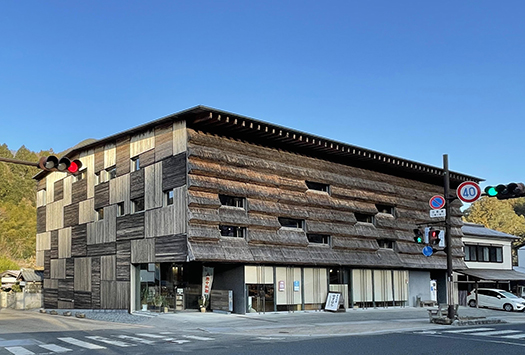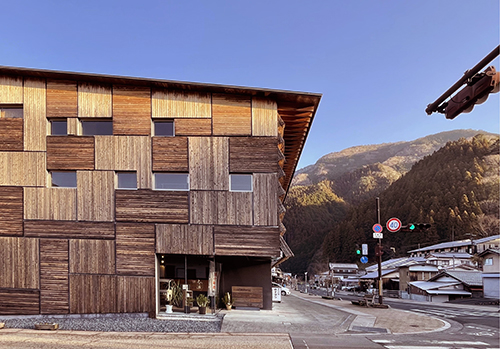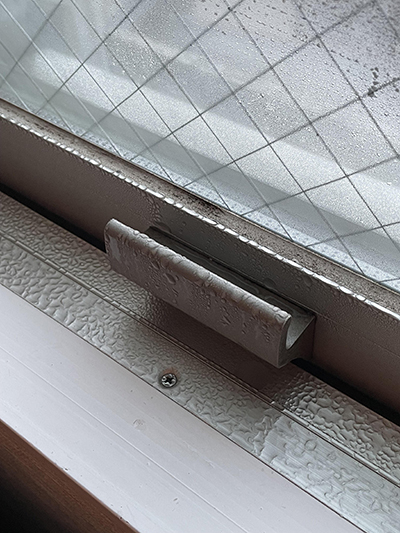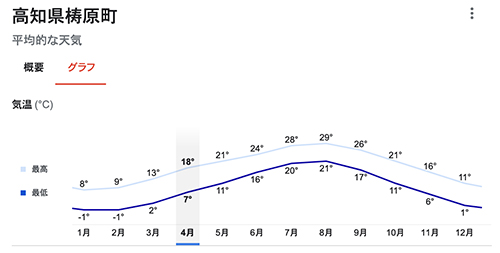


隈研吾の梼原町での建築の最初は「雲の上のホテル」だったそうですが、現在まだ建て替え工事中。やむなく写真の町営ホテル「まちの駅ゆすはら」に宿泊させていただいた。ただ、温泉設備はないのでいったん外出して、記事掲載した「雲の上のギャラリー」に隣接する温泉に入浴してから帰ってきた。
さすがに当日高知市から各所を回っての宿泊なのでかなり肉体疲労。温泉施設までの距離は往復20分程度なのですが、自然豊かな梼原なので市街地エリアはほんのちょっとで信号待ちも1回程度。あまり距離感は感じなかった。また温泉施設での露天風呂も、いかにも雲の上の温泉っぽくて抜群の眺望でついついウットリした気分に。就寝をここちよく誘ってくれたので、ホテル帰還後、寝心地もよくバタンキュー。
ということだったのでホテルの施設についてチェックは不十分だった。ワークデスク周りの電源コンセント位置や、照明とベッド配置について疑問を感じる部分もあって勝手が違ったりもした次第。また水回り・バスルームの床面が仕切りが明確でなかったので、ちょっと足下に不都合を感じた。まぁご愛敬。
1月時期、南国とはいえ、雲の上という高地なので一部には積雪も見られていたのですが、エアコン暖房でそこそこは寝心地よく休めた。


で、朝方めざめて窓カーテンを開けてみたら、アルミサッシ窓はごらんのような状況。建築データなどのディテールまで確認していませんが、いかにも蒸暑地的な開口部材選択だったようです。ガラスは単板で網入り。網入りと言うことは市街地としての仕様条件・選択だったと思われます。
ちなみに梼原町の年平均気温グラフは上図の通り、1月だと最低気温はマイナス1度。温暖地域では防寒仕様の樹脂サッシなどの流通は少なく、価格面でも都度取り寄せ的流通実態を反映して高額にならざるを得ないのが現実だとは思います。
以前、九州北部、博多近郊のリゾートホテルに正月の家族旅行で宿泊して、いかにも開放的な窓一面に結氷が発生していた宿泊経験があります。冬に温暖地域を旅する北国人はこういう現実にも出会う。冬の温暖地域旅行では、ある意味、覚悟しておく必要がある。
北海道十勝でLIXILさんの敷地内で「メーム」という誌的なネーミングのモデル建築・アイヌ語由来の「水の畔の家」を建てた隈研吾設計として期待していたのですが、・・・。まぁ町発注の公共建築であり、いろいろな仕様条件などの制約の中での選択なのだろうかと思います。
English version⬇
Hotel stay in Yusuhara and Kengo Kuma, Shikoku, in January.
The lowest temperature was -1°C. Even in Tosa-Kochi Prefecture, the highlands in the mountains have cold conditions with snowfall. What are the actual specifications for insulation and openings? ・・・・・.
Kengo Kuma’s first building in Yusuhara was the “Hotel on Clouds,” but it is still under reconstruction. We were forced to stay at the town hotel in the photo, “Machi-no-Eki Yusuhara. However, there are no hot spring facilities, so I went out and took a bath in the hot spring adjacent to the “Gallery Above the Clouds,” which was featured in the article, before returning home.
As one might expect, we were physically exhausted after traveling from Kochi City to various places on the day of our stay. The distance to the hot spring facility is about a 20-minute round trip, but because Yusuhara is rich in nature, the city area is only a short distance away, so I did not feel much distance. The open-air baths at the Yusuhara hot spring facilities were like a hot spring above the clouds, with an outstanding view that made me feel like I was in a good mood and invited me to go to bed, so I was able to sleep comfortably after my hotel stay.
I was so comfortable that I went to bed and fell asleep in a slumber after my hotel stay. I had some doubts about the location of power outlets around the work desk, and about the lighting and bed placement, which made me feel out of place. Also, the floor of the bathroom was not clearly partitioned, so I felt a little uncomfortable under my feet. Well, I’ll leave it at that.
In January, even though it was in a tropical area, there was snow in some parts because of the high altitude above the clouds, but I was able to rest comfortably sleeping there with the air conditioner heating.
When I woke up in the morning and opened the window curtains, I found that the aluminum sash windows were in the same condition as you can see. I did not check the details of the building data, but it seems that the choice of the opening material was very typical for a hot and humid climate. The glass is single-pane and screened. The glass is single pane and screened. The fact that it is screened suggests that it was selected for urban conditions and specifications.
Incidentally, the annual average temperature graph for Yusuhara is as shown above, with the lowest temperature in January being minus 1 degree Celsius. In warmer regions, there are few cold-resistant plastic sashes in circulation, and I think the reality is that the price must be high, reflecting the fact that the sashes are ordered on a case-by-case basis.
I once stayed at a resort hotel near Hakata in northern Kyushu for a New Year’s family vacation, and found ice forming all over the open windows. This is the kind of reality that northerners who travel to warm regions in winter encounter. In a sense, you need to be prepared for this when traveling to warm regions in winter.
I had high expectations for this project as designed by Kengo Kuma, who built a model building, “House by the Water” of Ainu origin, with the magazine-like name “Meme” on the site of LIXIL in Tokachi, Hokkaido, but ……. Well, it is a public building ordered by the town, and I guess it was chosen under the restrictions of various specifications and conditions.
Posted on 4月 3rd, 2023 by 三木 奎吾
Filed under: 住宅マーケティング, 出張&旅先にて







コメントを投稿
「※誹謗中傷や、悪意のある書き込み、営利目的などのコメントを防ぐために、投稿された全てのコメントは一時的に保留されますのでご了承ください。」
You must be logged in to post a comment.